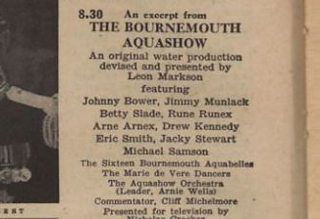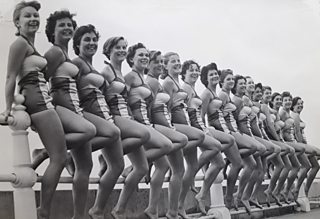Aquabelles - the inside story

The billing from Radio Times that brought back fond memories for Jeanne King
On 21 July 1955, �������� outside broadcast cameras went to visit a lively water spectacle in Bournemouth. The �������� Genome , The Bournemouth Aquashow, sparked a memory for one reader.
Jeanne King was 20 years old when she spotted an advertisement in her local paper for a new type of water show. Experienced swimmers were invited to apply and attend a test at the Bournemouth Pier Baths.
The year was 1952, and as a keen swimmer with ballet training, this seemed right up Jeanne’s street. She decided to go and audition.
“I’d always been a swimmer,” she says. “It runs in my family. We are like fish!”
“At my test, I realised this was an entirely new way of swimming for me. I had to put my head and neck up and grin at people – I couldn’t just plough through the water with my face down. “It was important that we were looking at the audience.”
The complex water manoeuvres choreographed for the water-performers – or Aquabelles - owed much to classical dance, and Jeanne’s early ballet training stood her in good stead. Her audition was successful and she became one of the first Aquabelles, whose performances formed part of an annual “Aquashow” at the Pier Approach Baths in Bournemouth.
Training began for the 1952 season, which was due to start at Easter. A choreographer travelled from Blackpool to teach the swimmers their routines.
“We had to learn to do different strokes. Swimming with one hand forward – tap, tap, tap in three places. It was very balletic.
“We did something like a conga, you were moving all the time but your arms made different movements and we used to change direction: Three strokes forward, then to the left, then to the right.
“It was making patterns on the water.”
Often a successful move relied on the swimmer attaining stillness in most of the body – using the slightest movement of the legs to propel them through the pool. The arms could then complete elaborate movements with the grace of a dancer.

Jeanne Manders, nee King, pictured with the other Aquabelles in 1953. Jeanne is right in the middle, 9th from the left or the right!
At that time, , and the chance to be taken to different locations and see what was going on - live as it happened - was an exciting novelty. Sport was, as now, one of the main attractions, but a wide variety of other spectacles was included, and each new stunt was widely publicised.
A Water Show was a complete spectacle, with dancers, acrobats and performers. Underneath the diving board, tarpaulins hung down into the water, allowing the Aquabelles to enter the pool unseen and then come out swimming. They swam under UV lighting that picked out different colours on their swimming costumes and hats. A pit at one end of the swimming pool was used to accommodate a lively orchestra.
“I just loved everything about it,” says Jeanne. “It was water ballet. Everything we did, it’s a bit like dancing to music. Our swimming strokes, everything - all went to the music.”
In 1955, Radio Times described the exercise of filming the “amphibious entertainment” at the Bournemouth Aquashow. “Cameras will have a three-fold task, keeping pace with goings-on in the pool, on the diving boards and on the stage which is erected above the pool itself.”
The high point for Jeanne came with the announcement that they would perform a special display in honour of Queen Elizabeth’s Coronation. The 16 Aquabelles’ finale was a "water mosaic", in which they floated in red white and blue costumes, spelling E II R in the water.
Was it the same as synchronised swimming? Not according to Jeanne: synchronised swimming is clever, but more mechanical, she says. The Aquabelle displays had much more in common with traditional dance. “It’s the difference between marching and gliding along,” she says.
Jeanne remained an Aquabelle until 1954, when she got married. The performances continued for years after that, including the one that was shown on �������� television in 1955.
Many local people remember being taken to see the show as children, says Jeanne, who often thinks of her days performing in the Water Show and wonders where her fellow Aquabelles are now.
“I’d love to find them.”